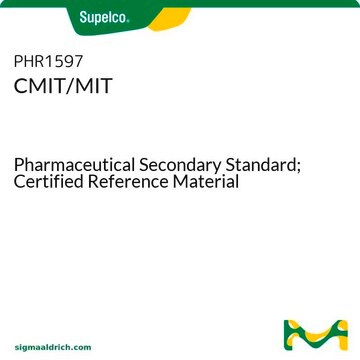The product is non-hazardous, the exact chemical composition of the modified alkyl carboxylate used in ProClin 300 is a proprietary information and hence not disclosed.
48912-U
ProClin™ 300
pkg of 50 mL, ProClin™ preservative for use in IVD manufacturing, CMIT/MIT 3 %
Synonym(s):
3% solution of 5-chloro-2-methyl-4-isothiazolin-3-one and 2-Methyl-4-isothiazolin-3-one
Select a Size
About This Item
Recommended Products
Quality Level
form
liquid
shelf life
3 yr
contains
Alkyl Carboxylate
composition
CMIT/MIT, 3%
packaging
pkg of 50 mL
parameter
<45 °C operating temperature
color
colorless to light yellow
matrix
Modified glycol
operating pH range
2.5-8.5
pH
4.1 (100 g/L)
bp
189 °C
mp
-40 °C
solubility
water: soluble
density
1.03 g/cm3
Looking for similar products? Visit Product Comparison Guide
General description
Application
Biochem/physiol Actions
Legal Information
Disclaimer
Signal Word
Danger
Hazard Statements
Precautionary Statements
Hazard Classifications
Acute Tox. 4 Inhalation - Acute Tox. 4 Oral - Aquatic Acute 1 - Aquatic Chronic 1 - Eye Dam. 1 - Skin Corr. 1B - Skin Sens. 1
Storage Class Code
8A - Combustible corrosive hazardous materials
WGK
WGK 3
Flash Point(F)
244.4 °F - closed cup
Flash Point(C)
118 °C - closed cup
Personal Protective Equipment
Choose from one of the most recent versions:
Already Own This Product?
Find documentation for the products that you have recently purchased in the Document Library.
Customers Also Viewed
Protocols
The article describes the sample preparation and photometric determination of silver concentration in water samples using Spectroquant® photometers and test kits.
Related Content
Products and support for mpox research, offering world-class reagents for immunoassay and molecular assay development.
-
Is there more information about the modified alkyl carboxylate matrix used for ProClin 300?
1 answer-
Helpful?
-
-
To use as a preservative for a buffer in an RUO kit, what are the reasons for using 48912-U over 46878-U?
1 answer-
Both ProClin 300 and Proclin 950 are only sold for use in In Vitro Diagnostic Use. Their usage is not allowed for Research Use Only (RUO).
Helpful?
-
-
Is the recommended level for ProClin usage (0.025 to 0.05%) based on the active ingredient or the product as it is supplied in the bottle?
1 answer-
The percent of active ingredients found packaged in the bottle is 3% as it is supplied in the bottle. The recommended usage range for ProClin 300 is 0.025% to 0.050%, based on the product. Thus, an active range for use is represented between 7.5 to 15 ppm.
Helpful?
-
-
What is the process of neutralizing ProClin, and can ProClin be safely disposed of as non-hazardous after neutralization?
1 answer-
ProClin 300 contains two active ingredients, CMIT and MIT. CMIT can degrade into non-hazardous by-products. MIT is less reactive and is degraded by various chemicals. The provided procedure degrades both the CMIT and MIT active ingredients, ensuring that once the solution is neutralized, CMIT and MIT are no longer present. The breakdown by-products are not hazardous.
Helpful?
-
-
Does anything in 48912-U interfere with Horseradish Peroxidase?
1 answer-
ProClin 300 is fully compatible with both horseradish peroxidase and alkaline phosphatase enzymes.
Helpful?
-
-
Proclin P30 preservative - what is the recommended shelf life from DOM?
1 answer-
The expiration date will be located on the lot-specific Certificate of Analysis.
Please access a Certificate in the DOCUMENTATION section of the product detail page:
https://www.sigmaaldrich.com/product/sial/48912-u#product-documentationHelpful?
-
-
Can I use proclin 300 for Blood and Plasma preservation? And can i use proclin 300 with K3 EDTA?
1 answer-
This product is used as a preservative in numerous products and preparations. Although it has been utilized in antibody preparations of ascites fluid, it is typically not used as a biocidal agent in whole blood, serum, or plasma. Suitability would have to be determined by the researcher. See the link below to review additional ProClin information:
https://www.sigmaaldrich.com/products/clinical-diagnostics/proclin-preservativesHelpful?
-
-
What is the working solution of ProClin? How to dilute ProClin?
1 answer-
While optimization may be required, the typical working range for ProClin 300 is 0.03 - 0.05%. See the link below for additional information on ProCliin product usage. Scroll down for the table referencing usage concentrations:
https://www.sigmaaldrich.com/products/clinical-diagnostics/proclin-preservatives.Helpful?
-
-
What is the concentration of active ingredients in ProClin 300?
1 answer-
ProClin 300 contains a total of 3% active ingredient.
Helpful?
-
-
When would I choose to use ProClin 300?
1 answer-
ProClin 300 is best used with production runs of standards, controls, and large volume buffers and solutions. The product is quite viscous and difficult to work with when trying to measure small volumes.
Helpful?
-
Active Filters
Our team of scientists has experience in all areas of research including Life Science, Material Science, Chemical Synthesis, Chromatography, Analytical and many others.
Contact Technical Service









